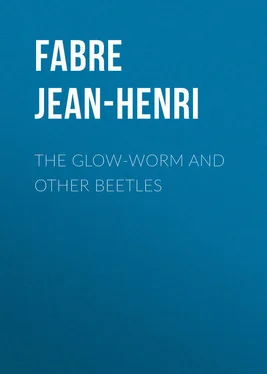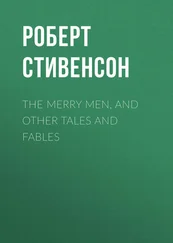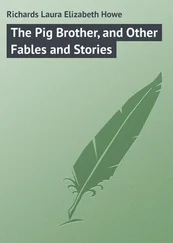Jean-Henri Fabre - The Glow-Worm and Other Beetles
Здесь есть возможность читать онлайн «Jean-Henri Fabre - The Glow-Worm and Other Beetles» — ознакомительный отрывок электронной книги совершенно бесплатно, а после прочтения отрывка купить полную версию. В некоторых случаях можно слушать аудио, скачать через торрент в формате fb2 и присутствует краткое содержание. Жанр: foreign_antique, foreign_prose, на английском языке. Описание произведения, (предисловие) а так же отзывы посетителей доступны на портале библиотеки ЛибКат.
- Название:The Glow-Worm and Other Beetles
- Автор:
- Жанр:
- Год:неизвестен
- ISBN:нет данных
- Рейтинг книги:5 / 5. Голосов: 1
-
Избранное:Добавить в избранное
- Отзывы:
-
Ваша оценка:
- 100
- 1
- 2
- 3
- 4
- 5
The Glow-Worm and Other Beetles: краткое содержание, описание и аннотация
Предлагаем к чтению аннотацию, описание, краткое содержание или предисловие (зависит от того, что написал сам автор книги «The Glow-Worm and Other Beetles»). Если вы не нашли необходимую информацию о книге — напишите в комментариях, мы постараемся отыскать её.
The Glow-Worm and Other Beetles — читать онлайн ознакомительный отрывок
Ниже представлен текст книги, разбитый по страницам. Система сохранения места последней прочитанной страницы, позволяет с удобством читать онлайн бесплатно книгу «The Glow-Worm and Other Beetles», без необходимости каждый раз заново искать на чём Вы остановились. Поставьте закладку, и сможете в любой момент перейти на страницу, на которой закончили чтение.
Интервал:
Закладка:
The luminescence, therefore, is controlled by the respiratory organs and the work produced is an oxidization. The white sheet supplies the oxidizable matter and the thick air-tube spreading into a tufty bush distributes the flow of air over it. There remains the question of the substance whereof this sheet is formed. The first suggestion was phosphorus, in the chemist's sense of the word. The Glow-worm has been calcined and treated with the violent reagents that bring the simple substances to light; but no one, so far as I know, has obtained a satisfactory answer along these lines. Phosphorus seems to play no part here, in spite of the name of phosphorescence which is sometimes bestowed upon the Glow-worm's gleam. The answer lies elsewhere, no one knows where.
We are better informed as regards another question. Has the Glow-worm a free control of the light which he emits? Can he turn it on or down or put it out as he pleases? Has he an opaque screen which is drawn over the flame at will, or is that flame always left exposed? There is no need for any such mechanism: the insect has something better for its revolving light.
The thick tube supplying the light-producing sheet increases the flow of air and the light is intensified; the same air-tube, swayed by the animal's will, slackens or even suspends the passage of air and the light grows fainter or even goes out. It is, in short, the mechanism of a lamp which is regulated by the access of air to the wick.
Excitement can set the attendant air-duct in motion. We must here distinguish between two cases: that of the gorgeous scarves, the exclusive ornament of the female ripe for matrimony, and that of the modest fairy-lamp on the last segment, which both sexes kindle at any age. In the second case, the extinction caused by a flurry is sudden and complete, or nearly so. In my nocturnal hunts for young Glow-worms, measuring about 5 millimetres long, 3 3 .195 inch. — Translator's Note .
I can plainly see the glimmer on the blades of grass; but, should the least false step disturb a neighbouring twig, the light goes out at once and the coveted insect becomes invisible. Upon the full-grown females, lit up with their nuptial scarves, even a violent start has but a slight effect and often none at all.
I fire a gun beside a wire-gauze cage in which I am rearing my menagerie of females in the open air. The explosion produces no result. The illumination continues, as bright and placid as before. I take a spray and rain down a slight shower of cold water upon the flock. Not one of my animals puts out its light; at the very most, there is a brief pause in the radiance; and then only in some cases. I send a puff of smoke from my pipe into the cage. This time, the pause is more marked. There are even some extinctions, but these do not last long. Calm soon returns and the light is renewed as brightly as ever. I take some of the captives in my fingers, turn and return them, tease them a little. The illumination continues and is not much diminished, if I do not press too hard with my thumb. At this period, with the pairing close at hand, the insect is in all the fervour of its passionate splendour; and nothing short of very serious reasons would make it put out its signals altogether.
All things considered, there is not a doubt but that the Glow-worm himself manages his lighting-apparatus, extinguishing and rekindling it at will; but there is one point at which the voluntary agency of the insect is without effect. I detach a strip of the epidermis showing one of the luminescent sheets and place it in a glass tube, which I close with a plug of damp wadding, to avoid too rapid an evaporation. Well, this scrap of carcass shines away merrily, although not quite as brilliantly as on the living body.
Life's aid is now superfluous. The oxidizable substance, the luminescent sheet, is in direct communication with the surrounding atmosphere; the flow of oxygen through an air-tube is not necessary; and the luminous emission continues to take place, in the same way as when it is produced by the contact of the air with the real phosphorus of the chemists. Let us add that, in aerated water, the luminousness continues as brilliant as in the free air, but that it is extinguished in water deprived of its air by boiling. No better proof could be found of what I have already propounded, namely, that the Glow-worm's light is the effect of a slow oxidization.
The light is white, calm and soft to the eyes and suggests a spark dropped by the full moon. Despite its splendour, it is a very feeble illuminant. If we move a Glow-worm along a line of print, in perfect darkness, we can easily make out the letters, one by one, and even words, when these are not too long; but nothing more is visible beyond a narrow zone. A lantern of this kind soon tires the reader's patience.
Suppose a group of Glow-worms placed almost touching one another. Each of them sheds its glimmer, which ought, one would think, to light up its neighbours by reflexion and give us a clear view of each individual specimen. But not at all: the luminous party is a chaos in which our eyes are unable to distinguish any definite form at a medium distance. The collective lights confuse the link-bearers into one vague whole.
Photography gives us a striking proof of this. I have a score of females, all at the height of their splendour, in a wire-gauze cage in the open air. A tuft of thyme forms a grove in the centre of their establishment. When night comes, my captives clamber to this pinnacle and strive to show off their luminous charms to the best advantage at every point of the horizon, thus forming along the twigs marvellous clusters from which I expected magnificent effects on the photographer's plates and paper. My hopes are disappointed. All that I obtain is white, shapeless patches, denser here and less dense there according to the numbers forming the group. There is no picture of the Glow-worms themselves; not a trace either of the tuft of thyme. For want of satisfactory light, the glorious firework is represented by a blurred splash of white on a black ground.
The beacons of the female Glow-worms are evidently nuptial signals, invitations to the pairing; but observe that they are lighted on the lower surface of the abdomen and face the ground, whereas the summoned males, whose flights are sudden and uncertain, travel overhead, in the air, sometimes a great way up. In its normal position, therefore, the glittering lure is concealed from the eyes of those concerned; it is covered by the thick bulk of the bride. The lantern ought really to gleam on the back and not under the belly; otherwise the light is hidden under a bushel.
The anomaly is corrected in a very ingenious fashion, for every female has her little wiles of coquetry. At nightfall, every evening, my caged captives make for the tuft of thyme with which I have thoughtfully furnished the prison and climb to the top of the upper branches, those most in sight. Here, instead of keeping quiet, as they did at the foot of the bush just now, they indulge in violent exercises, twist the tip of their very flexible abdomen, turn it to one side, turn it to the other, jerk it in every direction. In this way, the search-light cannot fail to gleam, at one moment or another, before the eyes of every male who goes a-wooing in the neighbourhood, whether on the ground or in the air.
It is very like the working of the revolving mirror used in catching Larks. If stationary, the little contrivance would leave the bird indifferent; turning and breaking up its light in rapid flashes, it excites it.
While the female Glow-worm has her tricks for summoning her swains, the male, on his side, is provided with an optical apparatus suited to catch from afar the least reflection of the calling-signal. His corselet expands into a shield and overlaps his head considerably in the form of a peaked cap or eye-shade, the object of which appears to be to limit the field of vision and concentrate the view upon the luminous speck to be discerned. Under this arch are the two eyes, which are relatively enormous, exceedingly convex, shaped like a skull-cap and contiguous to the extent of leaving only a narrow groove for the insertion of the antennæ. This double eye, occupying almost the whole face of the insect and contained in the cavern formed by the spreading peak of the corselet, is a regular Cyclop's eye.
Читать дальшеИнтервал:
Закладка:
Похожие книги на «The Glow-Worm and Other Beetles»
Представляем Вашему вниманию похожие книги на «The Glow-Worm and Other Beetles» списком для выбора. Мы отобрали схожую по названию и смыслу литературу в надежде предоставить читателям больше вариантов отыскать новые, интересные, ещё непрочитанные произведения.
Обсуждение, отзывы о книге «The Glow-Worm and Other Beetles» и просто собственные мнения читателей. Оставьте ваши комментарии, напишите, что Вы думаете о произведении, его смысле или главных героях. Укажите что конкретно понравилось, а что нет, и почему Вы так считаете.












